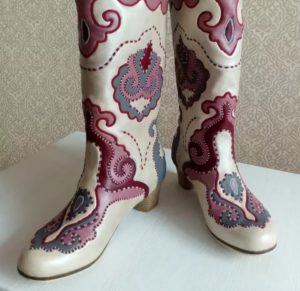 The shoes that conquered Europe! Ichigi - a fashionable novelty or an element of the Tatar folk costume? They won a medal in Paris. They were worn by the famous American dancer Isadora Duncan. Original shoes admiring in a German museum. The Chinese are racking their brains trying to replicate the sewing technology, while in the novel “War and Peace” Prince Bolkonsky appears before the reader in Tatar boots embroidered with silver.
The shoes that conquered Europe! Ichigi - a fashionable novelty or an element of the Tatar folk costume? They won a medal in Paris. They were worn by the famous American dancer Isadora Duncan. Original shoes admiring in a German museum. The Chinese are racking their brains trying to replicate the sewing technology, while in the novel “War and Peace” Prince Bolkonsky appears before the reader in Tatar boots embroidered with silver.
What kind of wonderful shoes are Ichigi?
Incredibly light, they are more like stockings with a hard back and a plastic toe. They are made from saffiano or yuft, which are types of soft, selected leather. They are sewn in shoe shops or factories.

Factory-made copies are unpretentious and simple, usually made of plain leather. Sewing does not take much time, which allows them to be produced in batches.

A craftsman spends up to one week on a couple of handmade ichizhny things. Leather flaps are painted in various colors and sewn together with silk threads. The seams are strong - reliability is ensured by the unique “Kazan” seam, the secret of which the master passes on to his students.

Hand-sewn boots are exclusive — the necessary patterns are selected for each pair, the master cuts out the details, selects colors and creates all kinds of ornaments. It was these picturesque boots with an ethnic pattern and heels that became part of the Tatar folk costume (photo).
Ichigi in history
The history of patterned boots begins in Kazan in the 19th century, when ichigi were sewn by craftsmen in villages, and their production was considered a home craft. At the beginning of the twentieth century, shoe making became an organized trade, and then rapidly gained momentum and developed into a local industry. From now on, Kazan is the center of shoe production, and people from all countries buy ichigs.

Ichigi - this national shoe of the Kazakhs is exhibited in the British Museum
The peoples of the Caucasus and Central Asia wear ichigs as house shoes. Before going outside, they put on kaushis on top - shoes made of rough leather with a flat, hard sole or high heels.
In their homeland, the ichigs and kaushis found admirers in the princely and noble families. On top of the ichigs, women wore kaushis with sharp, curved toes. More often they were made of red or green leather and embroidered with gold or silver thread. The male version of ichigs with kaushimi was more restrained. They were intended for walking and visiting.

The post-war period in Russia does not have the best effect on production - it is in decline. However, there is a huge interest in the art of folk crafts, and factories are being created to sew national shoes. This is how Ichizhi’s craftsmanship moves into the field of decorative and applied arts.
Features of female ichigas
Suitable for any time of year. Thin natural leather allows air to pass through well and does not overheat in hot weather. Having put on a warm sock, you can walk in them in spring and autumn, your feet will remain dry, even if you step in a deep puddle. Insulated with fur or felt, they will warm the feet of their owner in the winter cold.
The height of the boot varies from the beginning of the calf to the knee. In addition, the models differ in leather colors and decor. A variety of ornaments are obtained by connecting colored flaps with embroidery, which firmly fixes the leather mosaic and creates a kind of edging between its parts.

In the Muslim world, the image of living creatures on things is prohibited, so it is impossible to order boots with animals, insects or birds. All kinds of abstract shapes and plants become decorations. And the framing of these figures with embroidery with silk multi-colored threads makes the product truly exceptional and fabulous.
Fashion is constantly moving in a time circle. Each item is filled with its own history. This is where its charm and uniqueness lies. Once upon a time, ichigs became an integral part of the Tatar folk costume; now they can be called handmade designer shoes.


 0
0





